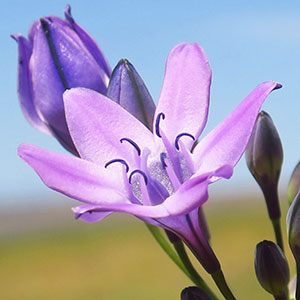Triteleia bridgesii
Triteleia peduncularis
Bridges' brodiaea, Bridges' triteleia
long-ray brodiaea, longray triteleia, marsh tritileia
20–55 cm × 3–10 mm.
20–40 cm × 5–15 mm.
10–60 cm, smooth except sometimes scabrous near base.
10–80 cm, smooth.
perianth lilac, bluish purple, pink, or reddish purple, 27–45 mm, tube strongly attenuate with slender base, 17–25 mm, hyaline vescicles present in tube, lobes abruptly spreading, 10–20 mm, shorter than tube;
stamens attached at 1 level, equal;
filaments triangular, widened toward base, 3–4 mm, apical appendages absent;
anthers bluish, 3.5–4.5 mm;
ovary 1/4–1/3 length of stipe;
pedicel 2–9 cm.
perianth white, often flushed violet or lilac abaxially, 15–28 mm, tube broadly funnelform-campanulate, acute at base, 7–11 mm, lobes 10–16 mm;
stamens attached alternately at 2 levels, unequal, those of proximal row shorter;
filaments nearly linear, slightly wider at base, 1–1.5 or 2–3 mm, apical appendages absent;
anthers white, 2–4 mm;
ovary bright yellow in flower, equal to stipe;
pedicel 2–10(–18) cm.
= 16.
= 14, 28.
Triteleia bridgesii
Triteleia peduncularis
Triteleia bridgesii is similar to T. laxa and in herbarium specimens can be distinguished only by the stamens. However, in fresh flowers, the perianth lobes of T. bridgesii spread abruptly from the throat of the perianth tube, unlike those of T. laxa, and the flowers of T. bridgesii are erect, while those of T. laxa are oriented horizontally. Triteleia bridgesii flowers a month earlier than T. laxa where they both occur in the Sierra Nevada foothills. The flowers in specimens of T. bridgesii from Humboldt County are unusually long, which accounts for the wide ranges of measurements for the perianth.
(Discussion copyrighted by Flora of North America; reprinted with permission.)
Triteleia peduncularis has a wide distribution in the northern California Coast Ranges, but it is usually not common and is quite rare south of San Francisco. The yellow ovary contrasts notably with the white perianth. The long-ascending pedicels are also distinctive. Triteleia ×tubergenii L. W. Lenz is a cultivated amphidiploid hybrid between T. laxa and T. peduncularis (L. W. Lenz 1970).
(Discussion copyrighted by Flora of North America; reprinted with permission.)


